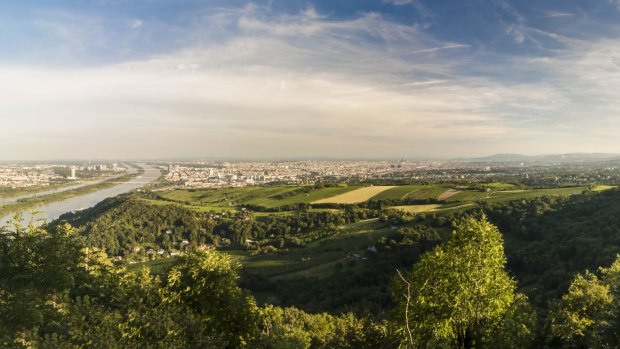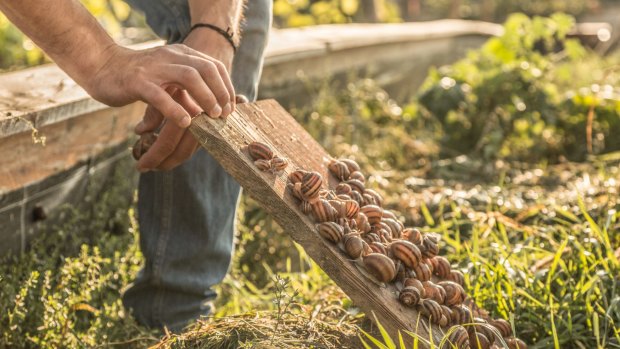This was published 1 year ago
Vienna places to eat: Eat your way through a truly magical city
By Katrina Lobley

It's hard to imagine how Vienna could be more magical.
My mouth drops open. I've just glimpsed Gustav Klimt's masterpiece The Kiss but the lovers, cloaked in a shimmer of gold, silver and platinum, are oblivious as I peek at them through a doorway at Vienna's Upper Belvedere museum. Even in a room dimmed by window shades, they're aglow, emitting some kind of slow burn. They're unaware of the admirers who have gathered at their feet to worship what is one of the world's most famous paintings - before turning their backs to snap a selfie. A guard confesses to witnessing the occasional proposal in here. I linger but no one drops to one knee.
Klimt's masterpiece, completed during what's known as his Golden Period, is just as alluring when I approach the work, muscling past others to inspect the hard geometric patterns that define the male figure and the soft circles that embroider the woman kneeling on a floral carpet of dots and splodges.
Those shapes on Klimt's canvas are as alluring as those of Vienna itself. The city is a spiral of 23 districts resembling the whorl of a snail shell. Once upon a time, so many locals feasted upon snails that there was a snail market where vendors marketed them as "Viennese oysters". Snails were particularly popular during Lent because they weren't considered meat. They were eaten by the rich, who might have paired them with pigeon, and the poor, who popped them into soups, sausages and goulash, says snail farmer Andreas Gugumuck.

Gugumuck grows his slow-moving food - snails.
In the 10th district on Vienna's southern outskirts, Gugumuck grows his slow-moving food in a field of herbs and vegetables (the farm can be visited on a guided tour, see gugumuck.com). We sample his snails in the 28-seat farm bistro, which serves a seven-course tasting menu that highlights snails and the farm's heritage plantings on some Friday nights (see website for dates). Snails also feature on the menu at Das Spittelberg (das-spittelberg.at), a restaurant serving Asian-accented modern Viennese food in the romantic, cobblestoned Spittelberg neighbourhood. It bakes them in Cafe de Paris butter, presenting them in a ceramic dish pocked with snail-sized nests visible only after cracking the golden crust.
More circles, tiny rising bubbles, catch my eye at Heuer am Karlsplatz – a sleek, glass-walled restaurant where everything old (pickling, canning, fermentation) is new again. I'm struck by my summery aperitif - an effervescent shrub'n'spritz comprising prosecco, vermouth, rosemary and soda – that precedes an elegant yet hearty lunch.
Karlsplatz (Charles Square), where the restaurant is located, sits just outside Vienna's most famous circle. The Ringstrasse – or the Ring – is a grand leafy boulevard encircling the World Heritage-listed historic centre. In normal times, a tram trundles its 5.3 kilometre length during the day and, in the early evening, a heritage tram takes a more leisurely swing past the treasures lining its route: the Vienna State Opera, Parliament, City Hall, the Imperial Palace and the Konzerthaus. Improbably, some of these grand buildings house rooftop beehives (lush Vienna is home to so many hives you can buy district-specific honey).
The Ring tram is temporarily closed. It's still possible to cover lots of ground, though, by heading to bike-rental company Pedal Power (near Karlsplatz but it can also deliver bikes to your hotel). We spin our hired wheels along the Ring to reach the Danube Canal and nip down a slope to find Strandbar Herrmann (www.strandbarherrmann.at), an improbable waterfront beach bar complete with sand and deckchairs. From April to September, it pumps with the thirsty after-work crowd but even mid-morning, people are chilling in deckchairs and I start to understand why Vienna keeps topping those "world's most liveable city" polls (at least it did until last year, when it plummeted to 12th due to the impact of COVID-19 restrictions).
We whiz along beneath leafy trees bordering the canal and cross a footbridge to dive into the Prater. This stately 1295-hectare park was an imperial hunting and riding ground reserved for the aristocracy until Emperor Josef II declared it a public park in 1766. Composer Johann Strauss performed at the Prater – I can imagine citizens quite forgetting themselves and twirling and swirling to his waltzes. The Prater's amusement park houses the giant Ferris wheel (wienerriesenrad.com) that opened in 1897. Modern attractions include the Prater Tower (praterwien.com) with its high-rise swing carousel, visible from miles away.
Back at Karlsplatz we hop over to the Naschmarkt, a produce market that's been around for centuries. My eyes grow rounder as I take in fat doughnut peaches, figs and apricots stuffed with soft cheese and studded with almonds, poppy cakes formed from potato dough, and cured mangalitsa – a type of adorable woolly pig.
We time-travel back a few decades at Vollpension (vollpension.wien), a cafe decorated with mismatched armchairs, velvet sofas, crochet-trimmed tablecloths, sepia wedding portraits, plastic trophies and vintage gossip magazines. The difference between this place and other kitsch cafes is it employs omas (grandmas) and opas (grandpas) to make and serve baked goods. The cafe's mission is to diminish the generation gap and reduce what it calls "contact poverty" for seniors. After inspecting the goodies cabinet, I plump for Frau Kathrin's poppy-chocolate cake and Frau Ela's fruit cake with buckwheat, along with an iced coffee.
I'll develop a pot belly if I keep eating like this. It's time to channel Beethoven, who would stroll between the wine villages north-west of Vienna when he summered in an apartment that's now part of the Beethoven Museum (wienmuseum.at). To find this place, look for the sinuous loops of a treble clef set within the cobblestones outside. In the undulating 19th district, we huff and puff past Riesling vines interspersed with red poppies and purple thistle flowers. The juxtaposition of curling vines and tendrils set against the city high-rises and distant Danube pleases the eye – but looming black clouds not so much.
Fat drops plop, snails slither onto the path and perhaps it's a divine force that drives the rain sideways, making our hair as wild as old Ludwig's and forcing an early retreat into a convivial buschenschank (a smaller, more limited version of a heuriger or wine tavern). At Buschenschank in Residence (open Fridays to Sundays, late May to early July), we sip wines made by Jutta Ambrositsch (jutta-ambrositsch.at) and work over plates of cheeses, beetroot, potatoes and pretty pickled vegetable salads. Later, there's more wining and dining at Mayer am Pfarrplatz (pfarrplatz.at) – a heuriger in a charming home where Beethoven lived and worked in 1817.
It's hard to imagine how Vienna could be more magical but it farewells us with a final flourish. In the north-east at the Marina Hofbauer (marina-hofbauer.at), we rent an electric boat on a bluebird afternoon to nose around the Old Danube (alte-donau.info), a former river branch that's become an enchanting lake. As dappled sunlight dances over our faces, we cruise past curvaceous race-car pedal boats with slippery-dip roofs, teens arcing off jetties in a reverse swan dive and the occasional bare breasts and buttocks of the sunbathing Viennese. We pop some fizz; drink it all in. These are golden days indeed.
Katrina Lobley was a guest of the Austrian National Tourism Office.
TRIP NOTES
MORE
STAY
The 533-room Motel One Vienna-Hauptbahnhof, near Vienna Central Train Station, is a budget design hotel that's a short walk to the Belvedere complex (belvedere.at). The 24-room Hotel Schani Salon is within an Art Nouveau house built in 1906 in the hip 7th district; it's located along the city's longest shopping street. See motel-one.com, hotelschani.com
FLY
Emirates and Qatar Airways both fly from Australia to Vienna via the Middle East. See emirates.com, qatarairways.com
VISIT
The Vienna City Card can cover public transport, museum discounts, airport transfers and/or the hop-on, hop-off bus over one to three days. See viennacitycard.at
Sign up for the Traveller Deals newsletter
Get exclusive travel deals delivered straight to your inbox. Sign up now.